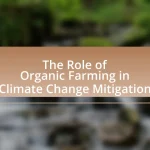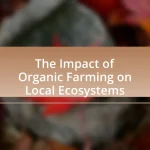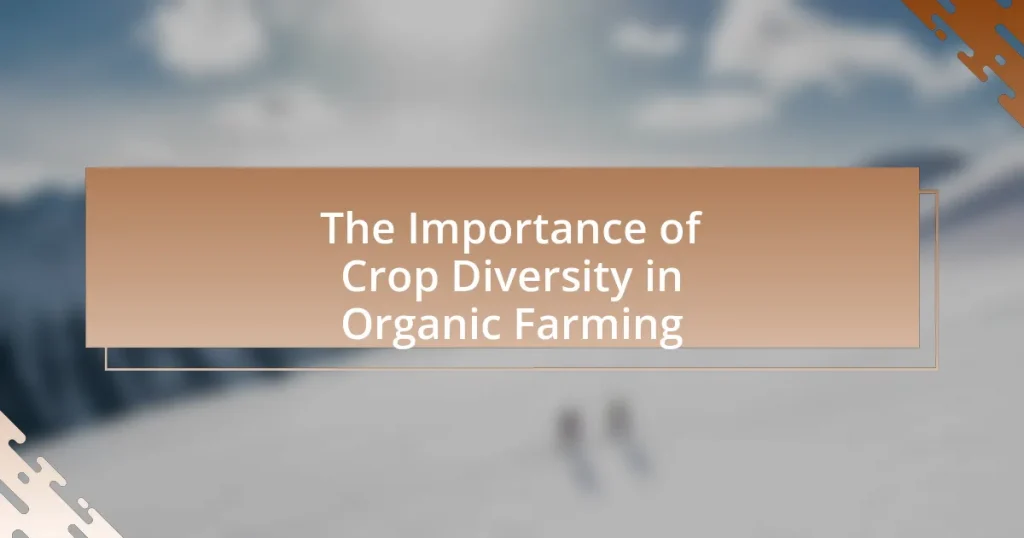Crop diversity is a fundamental aspect of organic farming that significantly enhances ecosystem resilience, soil health, and crop yields. This article explores the critical role of crop diversity in sustainable agriculture, highlighting its benefits in pest management, soil fertility, and climate change resilience. It discusses how diverse cropping systems can lead to increased productivity, reduced reliance on chemical inputs, and improved economic opportunities for farmers. Additionally, the article addresses the challenges faced by farmers in adopting crop diversity and outlines best practices and resources available to support this transition.
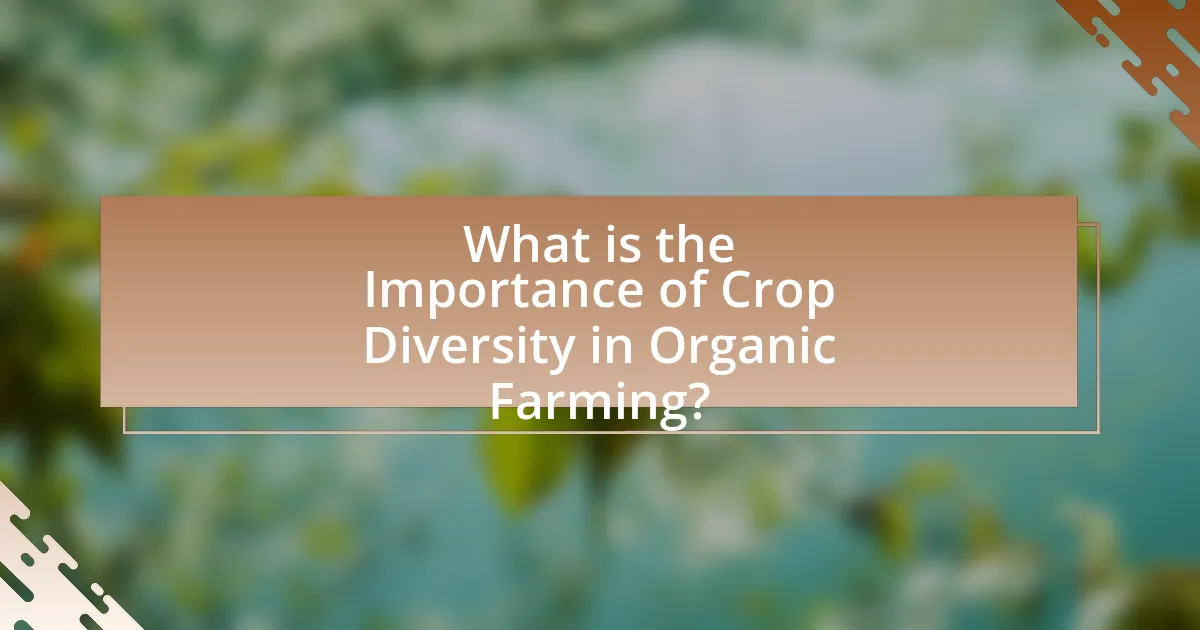
What is the Importance of Crop Diversity in Organic Farming?
Crop diversity is crucial in organic farming as it enhances ecosystem resilience, improves soil health, and increases crop yields. Diverse crops can better withstand pests and diseases, reducing the need for chemical interventions. Research indicates that farms with higher crop diversity can yield up to 20% more than monoculture systems due to improved pollination and nutrient cycling. Additionally, diverse cropping systems contribute to sustainable agriculture by promoting biodiversity, which is essential for maintaining ecological balance and supporting various organisms in the environment.
Why is crop diversity essential for sustainable agriculture?
Crop diversity is essential for sustainable agriculture because it enhances ecosystem resilience, improves soil health, and increases food security. Diverse crops can better withstand pests and diseases, reducing the need for chemical inputs and promoting natural pest control. Research shows that farms with higher crop diversity can yield up to 20% more than monoculture systems, as diverse plantings improve nutrient cycling and soil structure. Additionally, crop diversity supports a wider range of beneficial organisms, which contributes to a balanced ecosystem, ultimately leading to more sustainable agricultural practices.
How does crop diversity contribute to soil health?
Crop diversity significantly enhances soil health by improving soil structure, increasing nutrient availability, and promoting beneficial microbial activity. Different crops have varying root structures and nutrient requirements, which leads to a more balanced nutrient profile in the soil. For instance, legumes fix nitrogen, enriching the soil for subsequent crops. Research indicates that fields with diverse crops can have up to 30% higher soil organic matter compared to monoculture systems, which directly correlates with improved soil fertility and resilience. Additionally, diverse cropping systems foster a wider range of soil microorganisms, which play a crucial role in nutrient cycling and disease suppression, further contributing to overall soil health.
What role does crop diversity play in pest management?
Crop diversity plays a crucial role in pest management by enhancing ecosystem resilience and reducing pest populations. Diverse cropping systems create habitats for beneficial organisms, such as predators and parasitoids, which help control pest populations naturally. Research indicates that farms with higher crop diversity experience lower pest incidence; for example, a study published in the journal “Agriculture, Ecosystems & Environment” found that polycultures can reduce pest damage by up to 50% compared to monocultures. This reduction occurs because diverse crops can disrupt pest life cycles and provide alternative food sources for natural enemies, ultimately leading to more sustainable pest management practices.
How does crop diversity impact yield and productivity?
Crop diversity positively impacts yield and productivity by enhancing ecosystem resilience and reducing pest and disease pressure. Diverse cropping systems can lead to improved soil health, better nutrient cycling, and increased pollinator activity, all of which contribute to higher overall yields. Research indicates that farms with higher crop diversity can achieve yield increases of 20-30% compared to monocultures, as demonstrated in studies published in the journal “Agriculture, Ecosystems & Environment” by Tilman et al. (2014). This evidence supports the notion that crop diversity is crucial for sustainable agricultural practices and improved productivity in organic farming.
What are the effects of monoculture versus diverse cropping systems?
Monoculture negatively impacts soil health and biodiversity, while diverse cropping systems enhance ecosystem resilience and productivity. Monoculture, the practice of growing a single crop over a wide area, leads to soil degradation, increased pest and disease susceptibility, and reduced nutrient availability. In contrast, diverse cropping systems, which involve cultivating multiple crop species, promote beneficial interactions among plants, improve soil structure, and enhance nutrient cycling. Research indicates that farms practicing crop diversity can yield 20-60% more than monoculture systems due to improved pest control and soil fertility, as shown in studies by the Food and Agriculture Organization.
How can crop diversity enhance resilience to climate change?
Crop diversity enhances resilience to climate change by providing a wider range of genetic traits that can withstand varying environmental stresses. This diversity allows for better adaptation to changing climate conditions, such as droughts, floods, and pests. For instance, studies have shown that diverse cropping systems can reduce the risk of total crop failure, as different species may respond differently to climate extremes. Research published in “Nature” by Isbell et al. (2015) indicates that ecosystems with higher biodiversity are more productive and stable, which supports the argument that crop diversity can mitigate the impacts of climate change on agricultural systems.
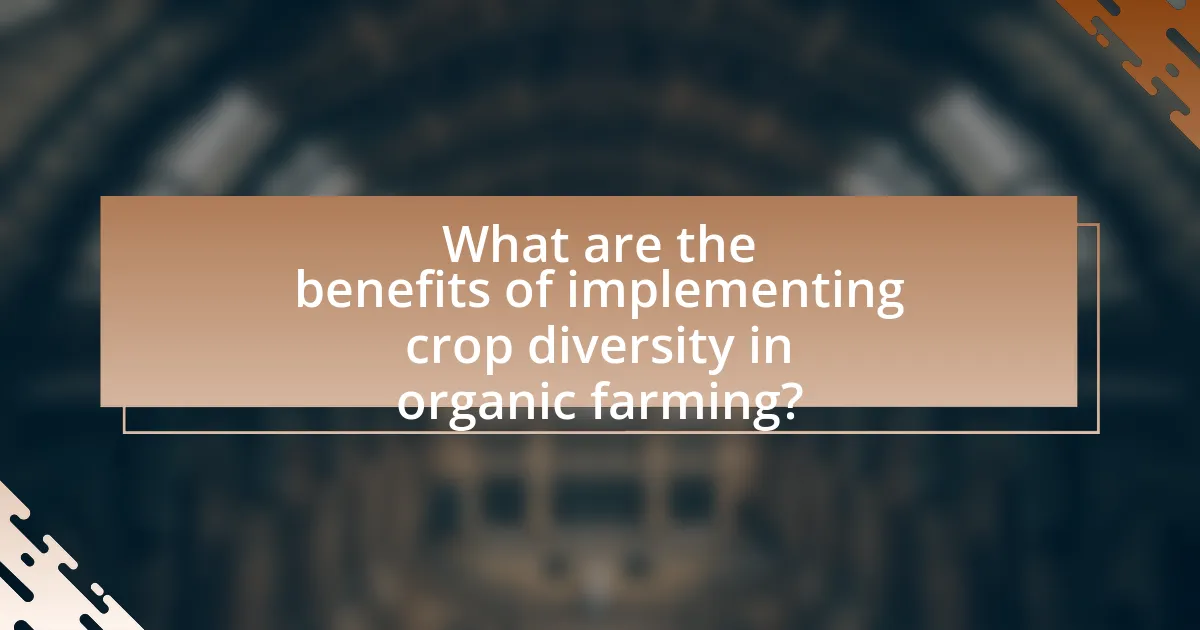
What are the benefits of implementing crop diversity in organic farming?
Implementing crop diversity in organic farming enhances ecosystem resilience, improves soil health, and increases yield stability. Diverse crops contribute to pest and disease management by disrupting pest life cycles and reducing the likelihood of outbreaks. Research indicates that farms with higher crop diversity can experience up to 20% higher yields compared to monoculture systems, as seen in studies conducted by the University of California. Additionally, crop diversity promotes beneficial interactions among plants, leading to improved nutrient uptake and reduced reliance on synthetic fertilizers. This multifaceted approach not only supports sustainable agricultural practices but also fosters biodiversity, which is crucial for long-term food security.
How does crop diversity improve ecosystem services?
Crop diversity improves ecosystem services by enhancing soil health, increasing resilience to pests and diseases, and promoting biodiversity. Diverse crops contribute to soil fertility through varied root structures and organic matter inputs, which improve nutrient cycling and soil structure. Additionally, a variety of crops can disrupt pest cycles and reduce the spread of diseases, leading to lower reliance on chemical inputs. Research indicates that farms with higher crop diversity can support a wider range of beneficial organisms, such as pollinators and natural pest predators, which further enhances ecosystem stability and productivity. For instance, a study published in “Nature” by Isbell et al. (2011) found that greater plant diversity significantly boosts ecosystem productivity and resilience, demonstrating the critical role of crop diversity in sustainable agricultural practices.
What specific ecosystem services are enhanced by crop diversity?
Crop diversity enhances several specific ecosystem services, including increased soil fertility, improved pest and disease regulation, and enhanced pollination services. Increased soil fertility occurs as diverse crops contribute various organic matter and nutrients, promoting healthier soil microbiomes. Improved pest and disease regulation is achieved through natural pest control mechanisms, as diverse plant species can disrupt pest life cycles and reduce outbreaks. Enhanced pollination services result from a variety of flowering plants that attract a wider range of pollinators, thereby increasing crop yields. These benefits are supported by studies showing that diverse cropping systems can lead to higher productivity and resilience in agricultural landscapes.
How does crop diversity support pollinator health?
Crop diversity supports pollinator health by providing a variety of food sources and habitats that enhance pollinator nutrition and habitat stability. Diverse crops attract a wider range of pollinators, such as bees and butterflies, which rely on different types of flowers for nectar and pollen. Research indicates that farms with higher crop diversity can increase pollinator abundance and species richness, leading to improved pollination services. For instance, a study published in the journal “Ecological Applications” found that farms with diverse plant communities had 50% more pollinator species compared to monoculture farms, demonstrating the direct link between crop diversity and pollinator health.
What economic advantages does crop diversity offer to farmers?
Crop diversity offers significant economic advantages to farmers by enhancing resilience against pests and diseases, which can lead to reduced crop losses and lower input costs. For instance, studies have shown that diverse cropping systems can decrease the need for chemical pesticides by up to 50%, thereby saving farmers money on inputs while also promoting environmental sustainability. Additionally, crop diversity can improve soil health and fertility, leading to higher yields over time. Research indicates that farms practicing crop rotation and intercropping can achieve yield increases of 10-20% compared to monoculture systems. This increased productivity directly translates to higher profits for farmers, making crop diversity a financially beneficial strategy in organic farming.
How can crop diversity lead to better market opportunities?
Crop diversity can lead to better market opportunities by allowing farmers to cater to a wider range of consumer preferences and demands. When farmers grow multiple crop varieties, they can tap into niche markets, such as organic or specialty products, which often command higher prices. For instance, a study by the Food and Agriculture Organization (FAO) indicates that diversified farming systems can increase farm income by up to 30% due to access to premium markets. Additionally, crop diversity enhances resilience against pests and diseases, reducing the risk of crop failure and ensuring a more stable supply, which is attractive to buyers. This stability can lead to long-term contracts and partnerships with retailers, further solidifying market opportunities.
What are the cost implications of diverse versus monoculture farming?
Diverse farming generally incurs higher initial costs compared to monoculture farming due to the need for varied seeds, equipment, and management practices. However, diverse farming can lead to long-term cost savings by enhancing soil health, reducing pest outbreaks, and improving resilience to climate change, which can lower the need for chemical inputs and increase yield stability. Research indicates that farms practicing crop diversity can reduce costs associated with pest management by up to 50% and improve overall profitability by diversifying income sources.

What challenges do farmers face in adopting crop diversity?
Farmers face several challenges in adopting crop diversity, including economic constraints, knowledge gaps, and market access issues. Economic constraints arise from the initial costs associated with diversifying crops, such as purchasing seeds and implementing new farming practices. Knowledge gaps can hinder farmers’ ability to effectively manage diverse crops, as they may lack information on best practices and pest management strategies. Additionally, market access issues can limit farmers’ ability to sell diverse crops, as consumers and markets may favor monocultures or specific crop varieties. These challenges are supported by research indicating that farmers often prioritize short-term economic returns over long-term sustainability, which can discourage the adoption of diverse cropping systems.
What are the common barriers to implementing crop diversity?
The common barriers to implementing crop diversity include economic constraints, lack of knowledge, and policy limitations. Economic constraints arise from the higher initial costs associated with diverse crop systems compared to monoculture practices, which can deter farmers from adopting such methods. Lack of knowledge refers to insufficient training and information on the benefits and management of diverse crops, leading to reluctance in implementation. Policy limitations often manifest as inadequate support or incentives for farmers to diversify their crops, which can hinder the adoption of practices that promote biodiversity. These barriers collectively impede the transition towards more sustainable agricultural systems that enhance resilience and productivity.
How do knowledge gaps affect the adoption of diverse crops?
Knowledge gaps significantly hinder the adoption of diverse crops by limiting farmers’ understanding of the benefits and practices associated with crop diversity. When farmers lack information on the advantages of diverse cropping systems, such as improved soil health, pest resistance, and increased resilience to climate change, they are less likely to implement these practices. Research indicates that regions with higher levels of agricultural education and extension services show greater adoption rates of diverse crops, highlighting the correlation between knowledge and practice. For instance, a study published in the journal “Agricultural Systems” found that farmers who received training on crop diversity were 40% more likely to diversify their crops compared to those without such training. This evidence underscores the critical role that knowledge plays in promoting crop diversity in organic farming.
What financial challenges do farmers encounter with crop diversity?
Farmers encounter several financial challenges with crop diversity, primarily due to increased costs and market uncertainties. The cultivation of diverse crops often requires higher initial investments in seeds, equipment, and labor compared to monoculture practices. For instance, a study by the Food and Agriculture Organization indicates that diversified farming systems can lead to a 20-30% increase in production costs. Additionally, farmers face market risks as diverse crops may not have established demand, leading to potential revenue instability. Research from the University of California highlights that farmers growing multiple crops may experience price fluctuations, making it difficult to predict income. These factors contribute to the financial strain on farmers who aim to implement crop diversity in their organic farming practices.
How can farmers overcome these challenges?
Farmers can overcome challenges in organic farming by implementing crop diversity strategies. By rotating different crops, farmers can enhance soil health, reduce pest and disease pressure, and improve resilience against climate variability. Research indicates that diverse cropping systems can lead to a 20-30% increase in yield stability compared to monocultures, as shown in studies conducted by the Rodale Institute. Additionally, integrating cover crops and companion planting can further enhance biodiversity, providing natural pest control and improving nutrient cycling. These practices not only mitigate risks but also promote sustainable farming practices that align with organic farming principles.
What resources are available to support farmers in diversifying crops?
Farmers can access various resources to support crop diversification, including agricultural extension services, government programs, and research institutions. Agricultural extension services provide practical advice and training on crop management and diversification strategies, helping farmers adopt new practices. Government programs, such as the USDA’s Sustainable Agriculture Research and Education (SARE) program, offer grants and funding opportunities specifically aimed at promoting crop diversity. Additionally, research institutions, like universities and agricultural research centers, conduct studies and provide resources on best practices for diversifying crops, including information on suitable crop varieties and sustainable farming techniques. These resources collectively enhance farmers’ ability to diversify their crops effectively.
How can community initiatives promote crop diversity in organic farming?
Community initiatives can promote crop diversity in organic farming by facilitating knowledge sharing, providing access to diverse seeds, and fostering collaborative farming practices. These initiatives often organize workshops and training sessions that educate farmers about the benefits of crop diversity, such as improved resilience to pests and diseases. For instance, community seed banks enable farmers to access a variety of heirloom and indigenous seeds, which enhances genetic diversity. Research indicates that farms with higher crop diversity can yield better overall productivity and sustainability, as evidenced by a study published in the journal “Agriculture, Ecosystems & Environment,” which found that diverse cropping systems can increase ecosystem services and reduce reliance on chemical inputs.
What best practices can enhance crop diversity in organic farming?
Implementing crop rotation is a best practice that can significantly enhance crop diversity in organic farming. Crop rotation involves alternating the types of crops grown in a specific area across seasons, which helps to improve soil health, reduce pest and disease cycles, and increase biodiversity. Research indicates that diverse cropping systems can lead to higher yields and better resilience against environmental stressors. For example, a study published in the journal “Agriculture, Ecosystems & Environment” by Tittonell and Giller (2013) found that diversified cropping systems can enhance ecosystem services and agricultural productivity. Additionally, intercropping, which involves growing two or more crops in proximity, can further promote diversity and optimize resource use, as demonstrated in various organic farming practices worldwide.
How can crop rotation be effectively implemented?
Crop rotation can be effectively implemented by systematically alternating different crops in a specific sequence over several growing seasons. This practice enhances soil health, reduces pest and disease cycles, and improves crop yields. For instance, rotating legumes with cereals can increase nitrogen availability in the soil, as legumes fix atmospheric nitrogen, benefiting subsequent crops. Research from the Rodale Institute indicates that diverse crop rotations can lead to a 20-30% increase in yields compared to monoculture systems, demonstrating the effectiveness of this agricultural strategy.
What role do cover crops play in promoting diversity?
Cover crops play a crucial role in promoting biodiversity by enhancing soil health, providing habitat for beneficial organisms, and supporting a diverse ecosystem. These crops, such as clover and rye, improve soil structure and fertility, which in turn fosters a variety of microbial life essential for nutrient cycling. Research indicates that cover crops can increase the abundance and diversity of soil organisms, including earthworms and beneficial insects, which contribute to pest control and pollination. Additionally, by preventing erosion and suppressing weeds, cover crops create a more stable environment that supports a wider range of plant and animal species, ultimately leading to a more resilient agricultural system.


